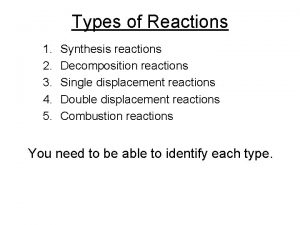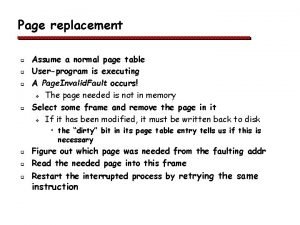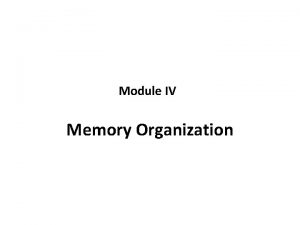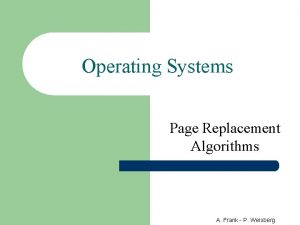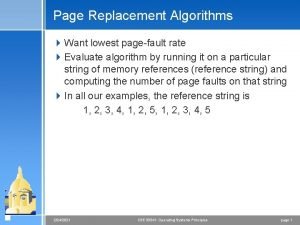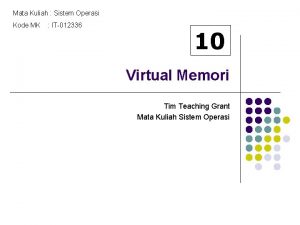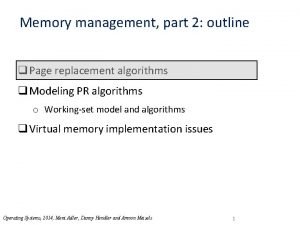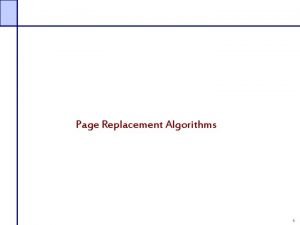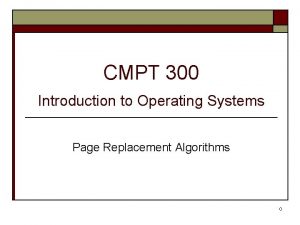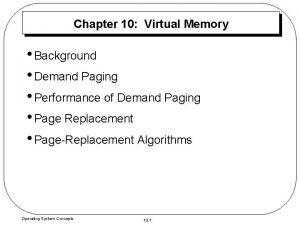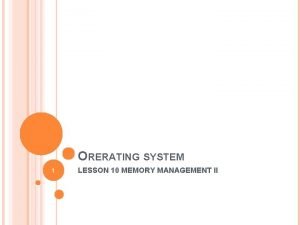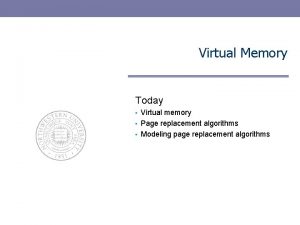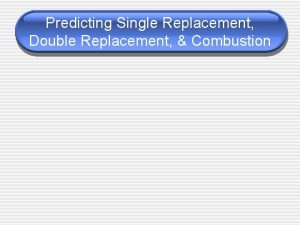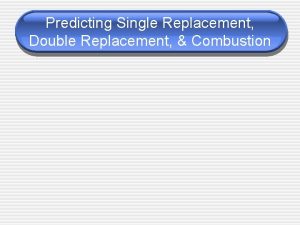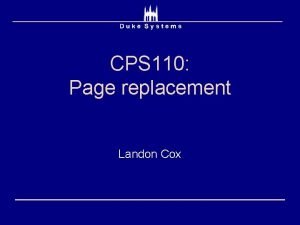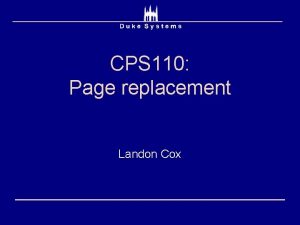Page Replacement Page Replacement Prevent overallocation of memory




















- Slides: 20

Page Replacement

Page Replacement � Prevent over-allocation of memory by modifying pagefault service routine to include page replacement � Use modify (dirty) bit to reduce overhead of page transfers – only modified pages are written to disk � Page replacement completes separation between logical memory and physical memory – large virtual memory can be provided on a smaller physical memory

Need For Page Replacement

Basic Page Replacement 1. Find the location of the desired page on disk 2. Find a free frame: - If there is a free frame, use it - If there is no free frame, use a page replacement algorithm to select a victim frame - Write victim frame to disk if dirty 3. Bring the desired page into the (newly) free frame; update the page and frame tables 4. Continue the process by restarting the instruction that caused the trap Note now potentially 2 page transfers for page fault – increasing EAT

Page Replacement

Page and Frame Replacement Algorithms � � Frame-allocation algorithm determines � How many frames to give each process � Which frames to replace Page-replacement algorithm � � � Want lowest page-fault rate on both first access and re-access Evaluate algorithm by running it on a particular string of memory references (reference string) and computing the number of page faults on that string � String is just page numbers, not full addresses � Repeated access to the same page does not cause a page fault � Results depend on number of frames available In all our examples, the reference string of referenced page numbers is 7, 0, 1, 2, 0, 3, 0, 4, 2, 3, 0, 3, 2, 1, 2, 0, 1, 7, 0, 1

Graph of Page Faults Versus The Number of Frames

First-In-First-Out (FIFO) Algorithm � Reference string: 7, 0, 1, 2, 0, 3, 0, 4, 2, 3, 0, 3, 2, 1, 2, 0, 1, 7, 0, 1 � 3 frames (3 pages can be in memory at a time per process) 15 page faults � Can vary by reference string: consider 1, 2, 3, 4, 1, 2, 5, 1, 2, 3, 4, 5 � Adding more frames can cause more page faults! � Belady’s Anomaly � How to track ages of pages? � Just use a FIFO queue

FIFO Illustrating Belady’s Anomaly

Optimal Algorithm � Replace page that will not be used for longest period of time � � How do you know this? � � 9 is optimal for the example Can’t read the future Used for measuring how well your algorithm performs

Least Recently Used (LRU) Algorithm n Use past knowledge rather than future n Replace page that has not been used in the most amount of time n Associate time of last use with each page n 12 faults – better than FIFO but worse than OPT n Generally good algorithm and frequently used n But how to implement?

LRU Algorithm (Cont. ) � Counter implementation � Every page entry has a counter; every time page is referenced through this entry, copy the clock into the counter � When a page needs to be changed, look at the counters to find smallest value � Search through table needed � Stack implementation � Keep a stack of page numbers in a double link form: � Page referenced: � move it to the top � requires 6 pointers to be changed � � But each update more expensive � No search for replacement LRU and OPT are cases of stack algorithms that don’t have Belady’s Anomaly

Use Of A Stack to Record Most Recent Page References

LRU Approximation Algorithms � LRU needs special hardware and still slow � Reference bit � With each page associate a bit, initially = 0 � When page is referenced bit set to 1 � Replace any with reference bit = 0 (if one exists) � We do not know the order, however � Second-chance algorithm � Generally FIFO, plus hardware-provided reference bit � Clock replacement � If page to be replaced has � Reference bit = 0 -> replace it � reference bit = 1 then: � set reference bit 0, leave page in memory � replace next page, subject to same rules

Second-Chance (clock) Page-Replacement Algorithm

Enhanced Second-Chance Algorithm � Improve algorithm by using reference bit and modify bit (if available) in concert � Take ordered pair (reference, modify) 1. (0, 0) neither recently used not modified – best page to replace 2. (0, 1) not recently used but modified – not quite as good, must write out before replacement 3. (1, 0) recently used but clean – probably will be used again soon 4. (1, 1) recently used and modified – probably will be used again soon and need to write out before replacement � When page replacement called for, use the clock scheme but use the four classes replace page in lowest non-empty class � Might need to search circular queue several times

Counting Algorithms � Keep a counter of the number of references that have been made to each page � Not common � Lease Frequently Used (LFU) Algorithm: replaces page with smallest count � Most Frequently Used (MFU) Algorithm: based on the argument that the page with the smallest count was probably just brought in and has yet to be used

Page-Buffering Algorithms � � Keep a pool of free frames, always � Then frame available when needed, not found at fault time � Read page into free frame and select victim to evict and add to free pool � When convenient, evictim Possibly, keep list of modified pages � � When backing store otherwise idle, write pages there and set to non -dirty Possibly, keep free frame contents intact and note what is in them � If referenced again before reused, no need to load contents again from disk � Generally useful to reduce penalty if wrong victim frame selected

Applications and Page Replacement � All of these algorithms have OS guessing about future page access � Some applications have better knowledge – i. e. databases � Memory intensive applications can cause double buffering � � OS keeps copy of page in memory as I/O buffer � Application keeps page in memory for its own work Operating system can given direct access to the disk, getting out of the way of the applications � � Raw disk mode Bypasses buffering, locking, etc

References � “Operating System Concepts, " by Abraham Silberschatz, et al, 9 th Edition, 2012, John Wiley & Sons Inc. � Operating Systems: A Spiral Approach 1 st Edition by Ramez Elmasri , A Carrick , David Levine
 Resource overallocation
Resource overallocation Combustion reaction
Combustion reaction Design and implementation issues of dsm
Design and implementation issues of dsm Shared pages
Shared pages Wsclock page replacement algorithm
Wsclock page replacement algorithm Lfu page replacement algorithm
Lfu page replacement algorithm Lru approximation algorithm
Lru approximation algorithm Optimal page replacement algorithm calculator
Optimal page replacement algorithm calculator Clock page replacement
Clock page replacement Second chance page replacement algorithm
Second chance page replacement algorithm Page replacement fifo
Page replacement fifo Types of page replacement algorithms
Types of page replacement algorithms Aging algorithm page replacement
Aging algorithm page replacement A fifo replacement algorithm associates with each page the
A fifo replacement algorithm associates with each page the Second chance page replacement algorithm
Second chance page replacement algorithm Virtual memory in memory hierarchy consists of
Virtual memory in memory hierarchy consists of Explicit memory
Explicit memory Logical address
Logical address Eidetic memory vs iconic memory
Eidetic memory vs iconic memory Long term memory vs short term memory
Long term memory vs short term memory Which memory is the actual working memory?
Which memory is the actual working memory?

